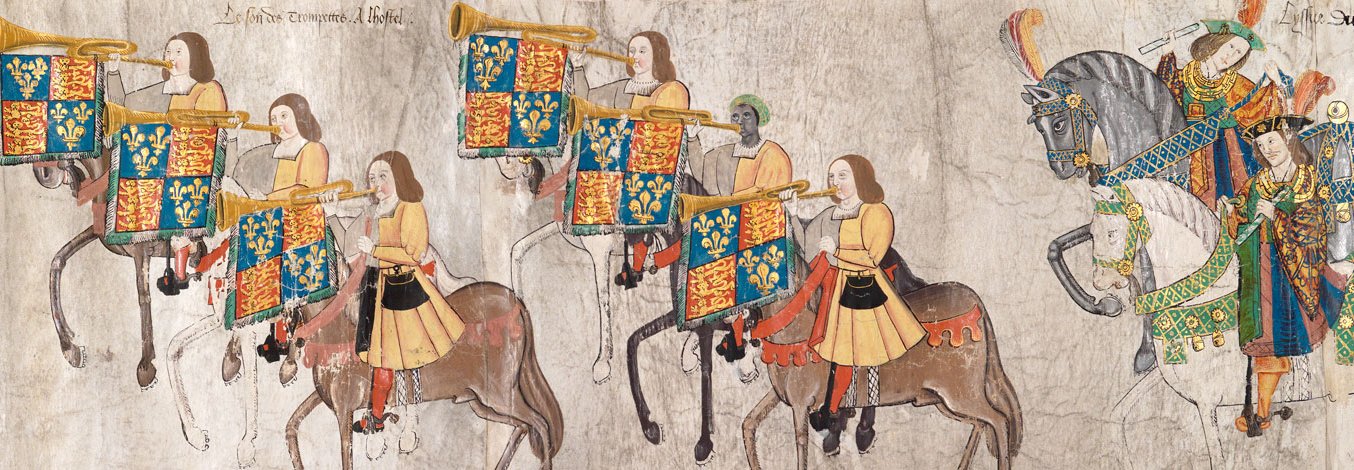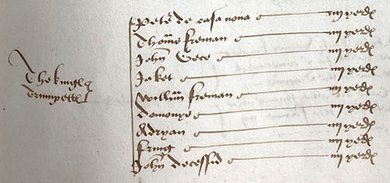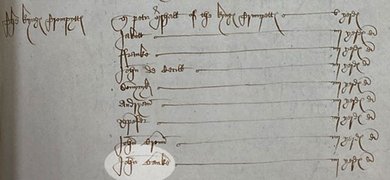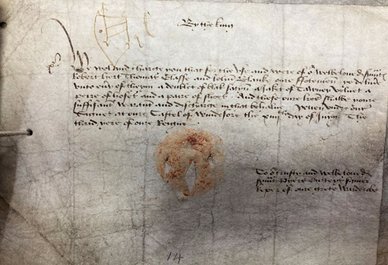John Blanke’s petition for a pay rise
Around 1512
This parchment records John Blanke, a Black Tudor in the royal court, asking King Henry VIII for a pay rise and a promotion in his role as a trumpeter.
John Blanke was a trumpeter at the courts of Henry VII and Henry VIII. He is one of the earliest people of colour in England we have records about.
College of Arms, Westminster Tournament Roll, 1511, Membrane 28. Reproduced by permission of the Kings, Heralds and Pursuivants of Arms.

Collections at The National Archives can help to explore the lives of individuals in the distant past. Records of the Crown swept up a lot of information on people who had connections to the monarch’s officials and their responsibilities. This record trail is often inconsistent and patchy, with family and friendship links difficult to prove. We sometimes have stronger evidence about people in direct service with royal figures, however. Our records can reveal their lives, jobs and networks.
John Blanke is one of them. His portrait appears twice in a tournament roll from 1511 (held by the College of Arms, shown above), and government records now at The National Archives and elsewhere provide some evidence of his career. The records explored so far by historians and the John Blanke Project suggest that he had a relatively brief period as one of the king’s trumpeters, between the end of 1507 and early 1512. John’s story is still unfolding for us, as new discoveries continue to develop our understanding of his life.
John’s surname was inconsistently spelled in contemporary records. He appears as Blak, Blake, Blank and Blanke.
The origin of John Blanke’s presence at the Tudor court is difficult to pin down. Historians have explained his appearance in England, as a Black African man, through the movement of people associated with the arrival of Katherine of Aragon to marry Arthur Tudor, Prince of Wales (1486–1502). The Spanish princess arrived in the autumn of 1501 with a very large entourage, ahead of her spectacular wedding on 14 November. That retinue included African people such as Catalina de Motril, from Granada. Katherine also brought several groups of minstrels and trumpeters to London. Their names are not known, but four distinct groups, including the princess’s own troupe, were well rewarded for their role in the wedding ceremonies.
If John Blanke arrived then, he made no impression in the records of the time examined so far. He was not among the eight trumpeters and their master, Peter de Casa Nova, named when they received mourning cloth ahead of the funeral of Queen Elizabeth (wife of Henry VII) in February 1503.

Record of the King's trumpeters receiving mourning cloth . Catalogue reference: LC 2/1, fol. 71r
One man, also named John, was recorded as deceased, so there might have been a vacancy that John Blanke filled. A partial list of musicians on 17 June 1503, linked to preparations for the journey of Henry VII’s daughter, Margaret, to marry James IV of Scotland, mentions no John Blanke. Another wages list in December 1506 names seven men without including John.
A year later, the record changes. November 1507 shows ‘John Blanke the blacke Trumpet’ receiving 8d per day. The following month, he is still recorded separately from the seven other trumpeters and at that lesser rate of pay – although he was still getting 2d per day more than the 6d standard daily rate for Crown service. On New Year’s Eve he appears still as ‘the blake Trumpet’ when receiving his earnings of 20 shillings. Generous rewards for performing at events supplemented these basic wages. All the trumpeters shared a gift of £5 on 1 January 1508, and at many other times.

The King's Book of Payments, 22 August 1505 – 21 April 1510, listing 'the blake Trumpet'. Catalogue reference: E 36/214
The list of black mourning cloth for King Henry VII’s funeral in April 1509 names all the king’s trumpeters – Jakett, Petir, Domynyk, John Cecile, Frank, Xpofer [Christopher], Adryan, John Broun and John Blank. There is now a second trumpeter list, probably the trumpeters for war, since some of those named men saw diplomatic or military service early in Henry VIII’s reign.

The Great Wardrobe's Accounts concerning special events, listing 'John Blank' receiving mourning cloth. Catalogue reference: LC 9/50
By June, at Henry VIII’s coronation, each named trumpeter received four yards of scarlet cloth for ceremonial gowns. John was named as ‘John Banke’ here.

The Great Wardrobe's Accounts concerning special events, listing 'John Banke' receiving scarlet cloth. Catalogue reference: LC 9/50
From that point, John Blanke is fully integrated into the group of trumpeters as the records of the royal chamber record their wages paid as a block. His relationship with the young king must have developed over this period, since, as John Blake, he soon petitioned for a wage increase in the post that the deceased trumpeter Dominic Justinian occupied. Henry VIII signed the undated warrant to show his assent to the promotion.

Around 1512
This parchment records John Blanke, a Black Tudor in the royal court, asking King Henry VIII for a pay rise and a promotion in his role as a trumpeter.
John Blanke’s marriage might have been at the root of this request. We know that it occurred around January 1512, since on 14 January the king authorised a gift of cloth for John’s wedding clothes. John explained in his petition that his wages were not now sufficient to maintain and keep him and match the level of service of the other trumpeters. Marriage could be an explanation for those changed circumstances.
The National Archives’ warrant for the wedding gift is damaged and gives few details of the items, but a related entry in the account book of the Great Wardrobe for 1511–12 (now British Library, Egerton MS 3025), offers more. It shows four yards of furred violet cloth, a lined black doublet, scarlet hose, a hat and a bonnet – costing a generous £9. The John Blanke Project has recently created an impression of John’s outfit. The names of the tailors, skinners and hatters involved might also provide initial clues to the location of John’s residence in London. William Hilton, who made the gown, for example, in April 1513 had his tailor shop in Langbourn in the parish of St Mary Wolnoth, Lombard Street, in London (C 131/98/6).
Monthly wage payments continue through to January and February 1513, when all 16 trumpeters are named. John Blanke is absent from the lists. It appears that his period of royal service either changed in nature or ended at some point during 1512.
Recent speculation has proposed that if he did arrive in England with the Spanish delegation in 1501, as a Spanish speaker and king’s trumpeter, his services might have been in demand for the English military expedition in alliance with King Ferdinand of Aragon, against the French in Bayonne in the summer of 1512. The campaign was disastrously led, and it is possible that John Blanke might have returned to Spain or died in the summer heat of the campaign. We do not currently know anything further to explain his disappearance from the records at that time.
That is not the end of the John Blanke story, however. A very recent discovery shows payments for a John Blank as a royal footman near the start of Henry VII’s reign, in June 1488.

By the King
We will and charge you that for the use and wear of our welbeloved servants Robert Hert, Thomas Glasse and John Blank our footmen, ye deliver unto every of them a doublet of black satin, a jacket of tawny velvet, a pair of hose and a pair of shoes. And these our letters shall be your sufficient warrant and discharge in that behalf. Given under our signet at our castle of Windsor the 14th day of June, the third year of our reign.
By the King
We will and charge you that for the use and wear of our welbeloved servants Robert Hert, Thomas Glasse and John Blank our footmen, ye deliver unto every of them a doublet of black satin, a jacket of tawny velvet, a pair of hose and a pair of shoes. And these our letters shall be your sufficient warrant and discharge in that behalf. Given under our signet at our castle of Windsor the 14th day of June, the third year of our reign.
Documents related to the accounts of the Keeper of the Great Wardrobe, 22 August 1486 – 21 August 1488, mentioning a John Blank. Catalogue reference: E 101/412/20
This evidence raises the possibility that Blanke was absent from the record until the end of 1507 because he was doing another job at court before becoming recognised for his musicianship.
Henry VII had three footmen at the start of the reign. Often, their low rank makes it difficult to track this group by name, but unusually, they appear individually in this document requesting the issue of summer clothing.
A footman was a young man’s role, since they were required to run ahead or alongside the king’s travelling entourage. Footmen also helped the king to dismount and generally assisted with royal journeys. Clothes and shoes wore out more regularly than those in other jobs, hence the frequent orders for replacements. As with related lowly roles that were nevertheless close to the king physically, footmen held some influence and often progressed to other senior positions.
Is this 1488 John Blank, footman, the same man as 1507 John Blanke, trumpeter? More work is needed to fill in the gaps, but if it is true and John was in the royal household long before Katherine of Aragon travelled to England, we might have a different story to tell for John’s route to musical prominence.